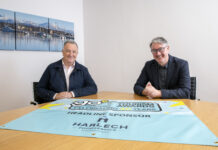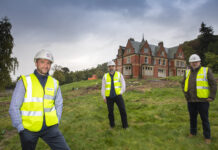The Houses of Parliament are full of old fossils – and that’s official.
A tech company from North Wales has created the first interactive map of fossils embedded in London’s historic buildings – including our historic seat of government in Westminster.
Llandudno-based Livetech teamed up with retired geologist Dave Wallis, from Colwyn Bay, who worked in the oil and gas industry, to build the ground-breaking London Pavement Geology website.
The map has revealed the Clipsham limestone used to repair the Gothic parliament building since the 1920s includes the fossils of echinoids or sea urchins dating back to the Middle Jurassic period more than 160 million years.
Other famous buildings featured on the map include Buckingham Palace and Westminster Abbey.
It is thought that London has the best collection of different types of rocks on the outside of buildings of anywhere in the world.
In fact, the website already has over 940 points included on the map. Each one has information about the type of rock, interesting details such as fossils, and where the stones came from.
Livetech are also developing an app to work in conjunction with the website which will work on iPhone, iPad and Android devices.
Paul Levy, owner of Livetech, said: “We created a mobile website which allows you to wander round and identify the geographical location of these interesting rocks, so it’s in an easily digestible format for anybody who is interested in having a completely different view of London.
“A lot of work has gone into the project from Dave and Ruth to provide the information that powers the site. This includes photos, making sure it’s accurately located, and verifying the information.”
Paul, 47, added: “The rise of the British Empire across the globe has resulted in London buildings being made from materials from every corner of the earth.
“You can go around the world in 80 minutes just by looking at all the different types of rock in these buildings.
“I find the diversity of where the materials have come from incredibly interesting. There are two aspects of it – the geographical location and the section of geological time – so not only are you having a journey round the world but a journey through history, back millions of years. It’s fascinating.”
Dave, 68, who retired 12 years ago, had the idea of documenting the rocks and fossils on London’s buildings way back in 1969.
The website started to come together after he met geologist Dr Ruth Siddall of University College London who has over the years collected a large tranche of personal data on the different rocks and fossils on London’s buildings.
Dave said: “Ruth had a database which she used regularly on her accompanied walks, in discussions with colleagues and documented in PDFs.
“She’s researched the architecture of buildings, particularly the facings on the front, and also where the raw materials – the stone – came from. Ruth even went back to quarries where the material were worked and was then able to identify the geological contexts .
“If you look at the website there are pins all over central London where she has identified the materials, researched the details, and taken photographs. Anyone can submit information and photographs through the website to be included.
“I wanted to put pins on a map that people could submit information on, enabling them to go and look if they are in London and have the time. We’ve had an explosion of data with almost 1,000 locations already loaded.
“London has probably the best collection of different rocks used on the outside of buildings in the world because the captains of industry during the industrial revolution spared no expense and they sent their architects to wherever they could find the best or most exotic materials.
“There are rocks on the outside of buildings from China, South Africa, India, Brazil, North America, and everywhere in Europe, just to make them look attractive. It’s a great opportunity to look at interesting and unusual stones.
“London is a geologist’s dream, without having to go and climb a cliff, or a mine. You can walk along with a cappuccino and a smartphone and without trying too hard you can see a huge range of rocks types, fossils and minerals.”
For more information about London Pavement Geology visit www.londonpavementgeology.co.uk and for more information about Livetech visit www.livetech.co.uk



























